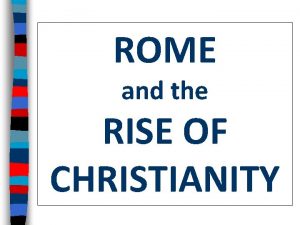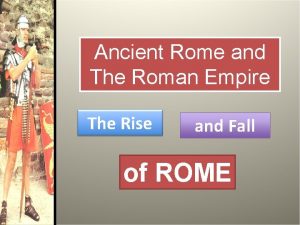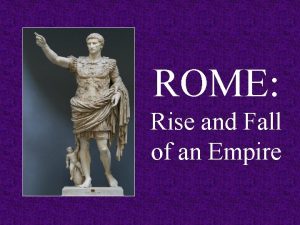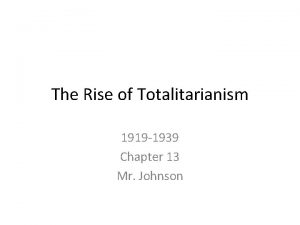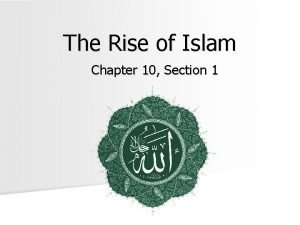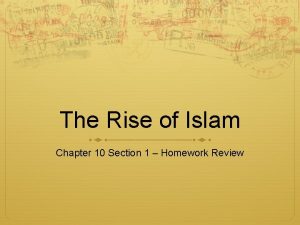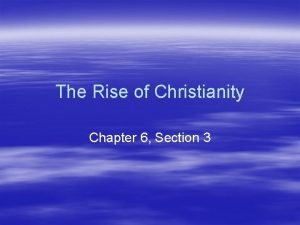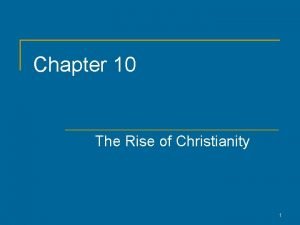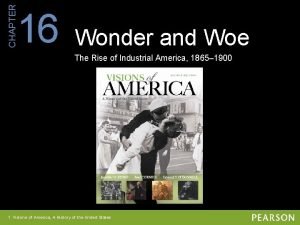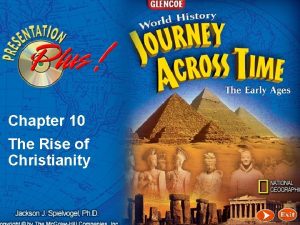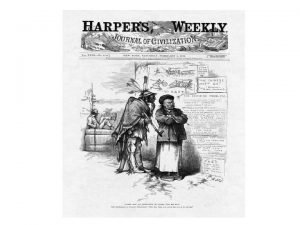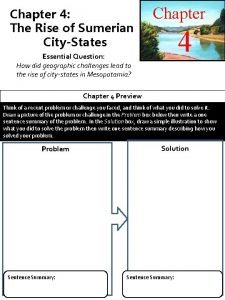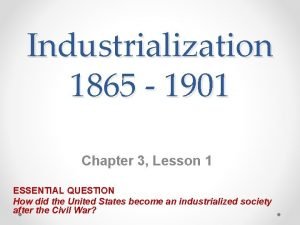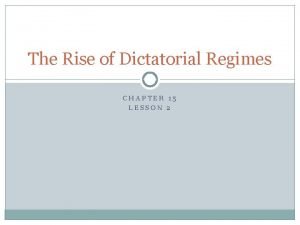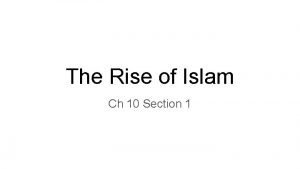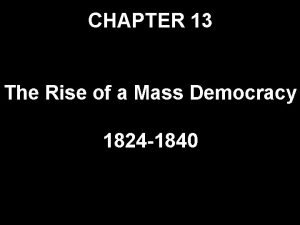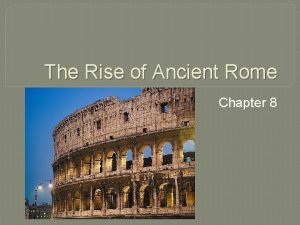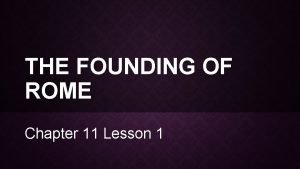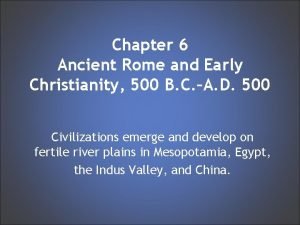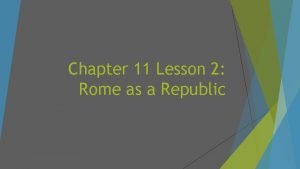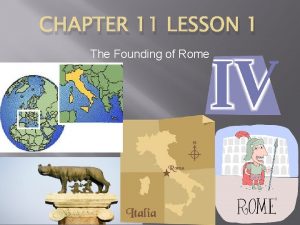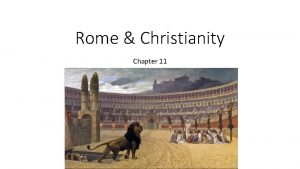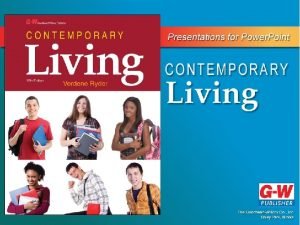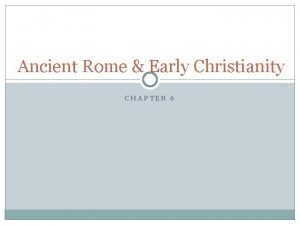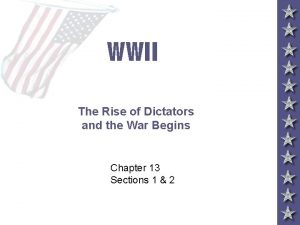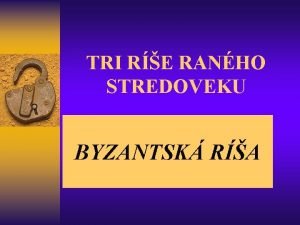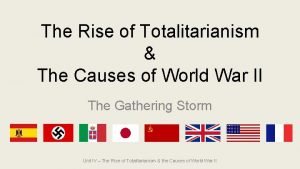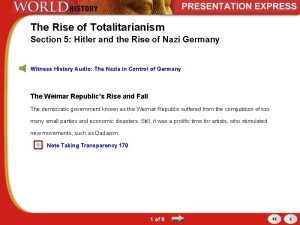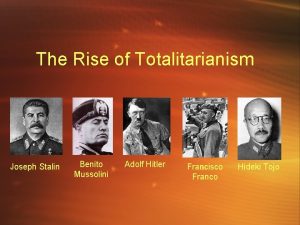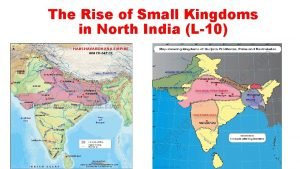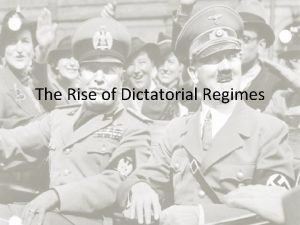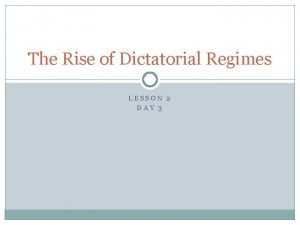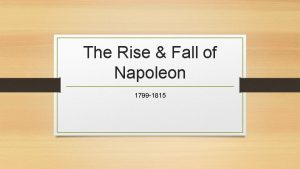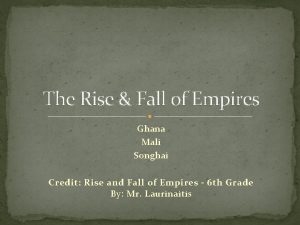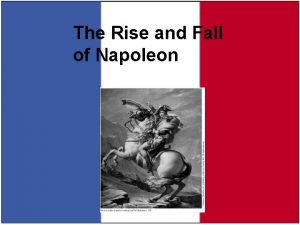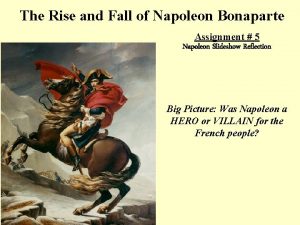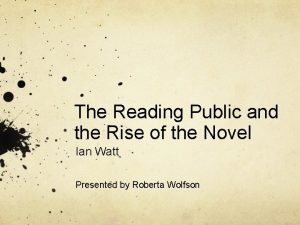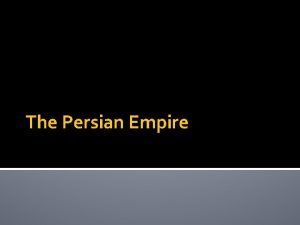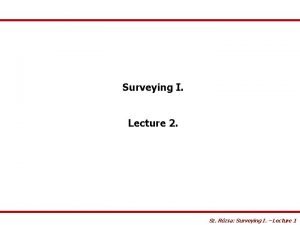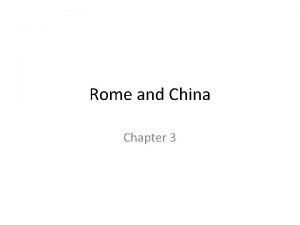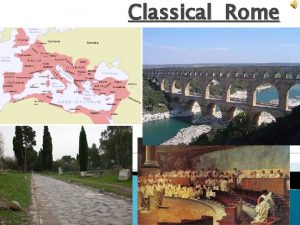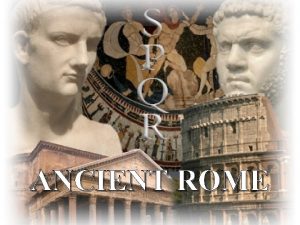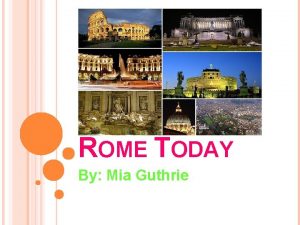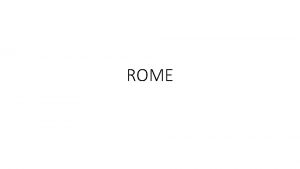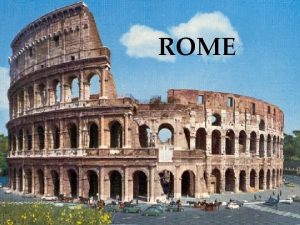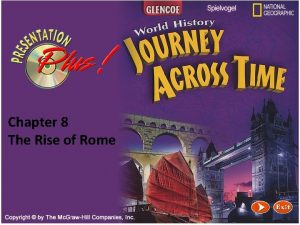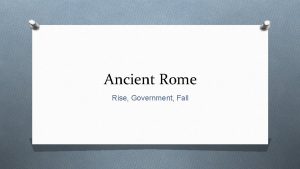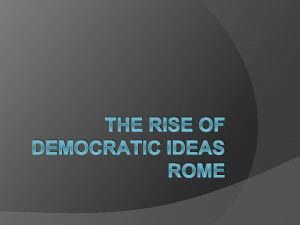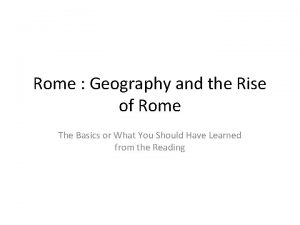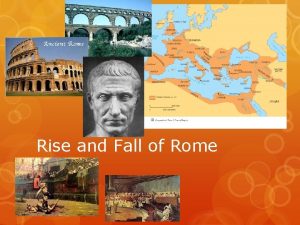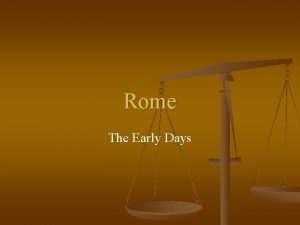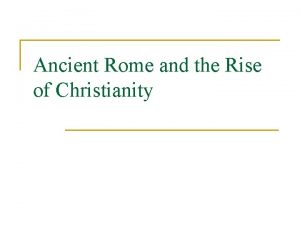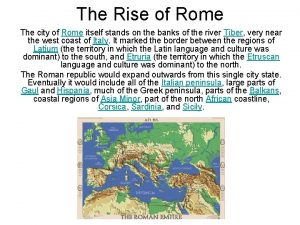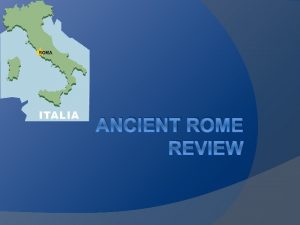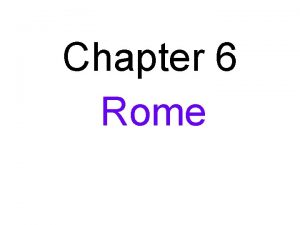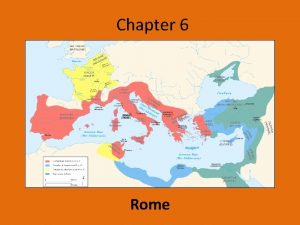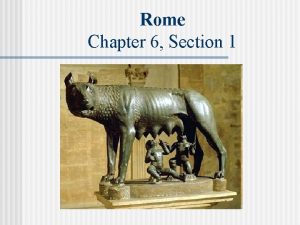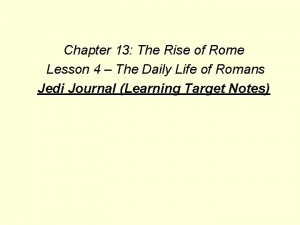Chapter 8 The Rise of Rome In your




























































































- Slides: 92

Chapter 8: The Rise of Rome In your notes, do a quick-write listing everything you know about Ancient Rome. Think about books, movies, mythology, and historical figures.

Things to come: � The founding of Rome › Aeneas › Romulus and Remus � Roman soldiers and war › Hannibal and the Punic Wars › The conquests of Julius Caesar � The peace of Rome (Pax Romana) and the crazy rulers › Caligula and Nero

SECTION 1: ROME’S BEGINNINGS Today we will explain in writing the importance of geography in the rise of the Roman Civilization. � Italy is in the middle of the Mediterranean Sea. � The Alps run across the top of Italy. › The Alps ________. � The Apennines run down through Italy, from North to South. *Look at the map on page 263. Answer 1 and 2 in your notes. › The Apennines can be crossed more easily, so ____________. � Italy had better farmland than Greece, so they ______.

SECTION 1: ROME’S BEGINNINGS Today we will explain in writing the importance of geography in the rise of the Roman Civilization. � The place where Rome was founded is 15 miles from the coast of the Mediterranean, on the ______. › The Tiber River gave Romans �a source of water �A way to the rest of the Mediterranean world �And ________ � Rome was built on ____. › This made it easy to ______. › It was also a stopping place for travelers in Italy and on the Sea.

SECTION 1: ROME’S BEGINNINGS Today we will explain in writing how the Romans created a republic and conquered Italy, turning it into a great power. � Romulus and Remus were brothers, abandoned as babies and raised by a wolf. Romulus killed Remus and ______. � Aeneas was a Trojan prince who escaped after the Greeks captured Troy. After a long adventure, he came to the Tiber River and founded Rome.

SECTION 1: ROME’S BEGINNINGS Today we will explain in writing how the Romans created a republic and conquered Italy, turning it into a great power. � The actual story? › Historians aren’t sure. They think that Latins lived in the hills of Rome, tending herds of animals, growing crops, and living in huts from 1000 B. C. › After a few hundred years, they banded together _____. Their community became known as Rome.

SECTION 1: ROME’S BEGINNINGS Today we will explain in writing how the Romans created a republic and conquered Italy, turning it into a great power. � The Etruscans and the ______ had a major influence on Rome. › Greeks taught Romans how to grow grapes and olives, and the Greek alphabet. Romans later copied their architecture, art, and writing. › Etruscans took control of Rome and ____. They were great fighters, their cities were well-organized, and they enjoyed feasting and playing sports and music.

SECTION 1: ROME’S BEGINNINGS Today we will explain in writing how the Romans created a republic and conquered Italy, turning it into a great power. � Rome became powerful under Etruscan rule, but the family of kings, the Tarquins, were ______. � In 509 B. C. , Rome rebelled and formed a republic. › The Roman Republic conquered their neighbors, including the Etruscans and the Greeks in southern Italy.

SECTION 1: ROME’S BEGINNINGS Today we will explain in writing how the Romans created a republic and conquered Italy, turning it into a great power. � Why was Rome so strong? › They had tough, disciplined fighters. › They created a new way of fighting, using legions. › They were smart planners. �They built settlements in places they conquered. �They built roads between these towns. �They treated conquered people well. �But they were forceful if they had to be.

SECTION 1: ROME’S BEGINNINGS Today we will explain in writing how the Romans created a republic and conquered Italy, turning it into a great power. � *** Create a power outline for a paragraph describing how the Romans created a republic and conquered Italy, turning it into a great power.

SECTION 2: THE ROMAN REPUBLIC Today we will describe in writing the Roman republic and legal system, its impact on Ancient Romans and how it relates to government today RECALL: *How were Romans treated under the Etruscan kings? *What kind of government did they form after they rebelled? CONNECT: What are the 3 branches of our government? � In early Rome, there were two social classes: patricians and plebeians. › Patricians were wealthy landowners. They could hold public office. › Plebeians were artisans, shopkeepers, and small farm owners. › Both groups were ______and both groups paid taxes and served in the ______. �Which group do you think was bigger? �Who had more respect? �Would they have been allowed to marry?

SECTION 2: THE ROMAN REPUBLIC Today we will describe the Roman republic and legal system, its impact on Ancient Romans and how it relates to government today. � Rome’s government had three parts: › A group who ran the government › A group who made laws › A group who served as judges � Checks and balances made sure no group became too powerful.

SECTION 2: THE ROMAN REPUBLIC Today we will describe the Roman republic and legal system, its impact on Ancient Romans and how it relates to government today. � In the Roman Republic, the top officials were the consuls. › There were 2 consuls. › They were elected for 1 year terms. › They could veto the other’s decision. › Would it be difficult for a consul to abuse their power? › Why would consuls be more likely to make good decisions? Praetors interpreted the law and acted as judges. � The Senate was made of 300 patrician men who served for life. � › At first they advised the Consuls. Later they could make laws and hold debates.

SECTION 2: THE ROMAN REPUBLIC Today we will describe the Roman republic and legal system, its impact on Ancient Romans and how it relates to government today. � In 494 B. C. , the plebeians rebelled because ______. � They set up the Council of Plebs and elected a tribune to bring their concerns to the government. › The tribunes had the right to veto government decisions. › Soon plebeians and patricians were allowed to marry. › In 287 B. C. , plebeians were allowed to make laws, too.

SECTION 2: THE ROMAN REPUBLIC Today we will describe the Roman republic and legal system, its impact on Ancient Romans and how it relates to government today. � In the Roman Republic, a dictator ruled for a short period of time during an emergency. › What is a dictator today? › Cincinnatus was a well-known dictator.

SECTION 2: THE ROMAN REPUBLIC Today we will describe the Roman republic and legal system, its impact on Ancient Romans and how it relates to government today. � Rome’s first code of laws was The Twelve Tables. › Laws were not written down before this. Plebeians demanded that laws be written down. › The laws were on display in the Forum. › This established the principle that all free citizens had the right to be treated the same way by the law. � The Law of Nations was created to solve disputes between citizens and non-citizens. › Important ideas about laws: �Innocent until proven guilty �People accused can defend themselves to a judge �A judge must use evidence before making a decision.

SECTION 2: THE ROMAN REPUBLIC Today we will describe the Roman republic and legal system, its impact on Ancient Romans and how it relates to government today. › In your notes, list three important contributions the Romans made to ideas about law and government. › Rank those in order of importance, with 1 being their most important contribution.

SECTION 2: THE ROMAN REPUBLIC Today we will � Rome had conquered Italy, but it write a paragraph had a rival in the Mediterranean: describing how Carthage, on the coast of Rome expanded its control _____. throughout the › Carthage had become wealthy by Mediterranean. controlling trade in northern Africa and southern Europe. › Carthage and Rome both wanted to control ____.

SECTION 2: THE ROMAN REPUBLIC Today we will write a paragraph describing how Rome expanded its control throughout the Mediterranean. � The First Punic War, 264 B. C. › Carthage vs. Rome › Cause: Rome sent an army to Sicily to prevent Carthage from taking it over. �Carthaginians already had colonies on the island wanted to stop the invasion. �Rome realized it needed a navy, and built a large fleet. › Effect: In 241, Rome won a naval battle. Carthage had to leave and pay Rome huge fines. Rome ruled Sicily (after 20 years!)

SECTION 2: THE ROMAN REPUBLIC Today we will write a paragraph describing how Rome expanded its control throughout the Mediterranean. � The Second Punic War › To make up for losing land, Carthage expanded its empire into southern Spain. Rome was not happy, and helped the Spanish ______. › Carthage sent its greatest general, Hannibal, to attack Rome in 218 B. C. , starting a war. › Hannibal’s strategy was to take the fighting to Italy. He gathered a huge army, including many horses and 37 ______. �What do you think of Hannibal’s strategy? Predict the outcome!

SECTION 2: THE ROMAN REPUBLIC Today we will � Hannibal’s army lost many men write a paragraph and animals crossing the Alps describing how Rome expanded into Italy because _____. its control › Cold, ______, and attacks by throughout the Mediterranean. mountain tribes killed almost half his soldiers.

SECTION 2: THE ROMAN REPUBLIC � Outcome: Today we will write a paragraph › Hannibal was still strong enough to do describing how damage to Rome’s army at the Battle Rome expanded of Cannae. His army raided much of its control Italy. throughout the Mediterranean. › The Romans raised another army. In 202 B. C. , General Scipio invaded ______. › Hannibal had to return home to defend Carthage. › Scipio beat Hannibal at the Battle of Zama. �Carthage gave up _____ �Carthage paid a huge fine to Rome. �Rome now ruled the western Mediterranean

SECTION 2: THE ROMAN REPUBLIC Today we will write a paragraph describing how Rome expanded its control throughout the Mediterranean. � Rome finally destroyed its rival in the Third Punic War. › They burned the city. › They enslaved 50, 000 men, women, and children. › They salted the land so _____. � Meanwhile, Rome also conquered Macedonia, Greece, and parts of Asia. › The Mediterranean became known to Romans as “mare nostrum”, or _____.

SECTION 2: THE ROMAN REPUBLIC � Outline a power paragraph, Today we will write a paragraph describing the causes and describing how Rome expanded outcomes of the Punic Wars. its control › Topic throughout the Mediterranean. �First Punic War �Cause �Effect �Second Punic War �Cause �Effect �Third Punic War �Cause �Effect › Conclusion

SECTION 2: THE ROMAN REPUBLIC � The Rise of Rome Today we will sequence the › Choose the 8 events in Rome’s important events early history that you think are most in the founding of Rome and the important, and sequence them in formation of the chronological order. Republic by creating a cartoon › On a piece of plain white paper, strip. create a cartoon strip showing each of the events. › Use dialogue or captions to describe what is happening. › Write you name on the back. � This will go on our outside bulletin board, so do your best work!

SECTION 3: THE FALL OF THE REPUBLIC � Quickwrite: Today we will describe how › What do you know about Julius Caesar? seized power and made reforms by › If you don’t know anything about writing a cause Caesar (yet), predict what will come and effect sentence. next in Rome’s history. �Flip back to your notes on The Rise of Rome if you need to!

SECTION 3: THE FALL OF THE REPUBLIC Today we will describe how Julius Caesar seized power and made reforms by writing a cause and effect sentence. Predict: What do you think these plebeian farmers did? � Rome’s armies were victorious, but there was trouble at home. �Recall: What lands had Rome conquered? �What was mare nostrum? � In the 100 s B. C. , Roman farmers were poor and in debt. › Some hadn’t been able to farm because _______. › Others’ farms had been destroyed by Hannibal’s troops. › They couldn’t compete with Roman latifundia, giant farming estates worked by ______.

SECTION 3: THE FALL OF THE REPUBLIC Today we will describe how Julius Caesar seized power and made reforms by writing a cause and effect sentence. Predict: What would the founders of Rome’s Republic think? � Farmers sold their farms and moved to Rome for work. � Jobs were ______, and they became angry. � Some patricians wanted to reform Rome’s problems, and asked the Senate to give these men small farms. › These men were ____. › Why would Senators refuse to give them land?

SECTION 3: THE FALL OF THE REPUBLIC Today we will � The Roman army began paying describe how soldiers and offered them land. Julius Caesar seized power and Generals became politicians to made reforms by writing a cause get land. and effect �How would this change the way sentence. soldiers felt? Who would they be loyal to? � A general named Sulla named Analyze: What it take for Rome to become a great city again? himself dictator and changed the government for the worse. › Sulla stepped down, hoping Rome could become great again, but it led to _____. › Other men saw what Sulla did and ______.

SECTION 3: THE FALL OF THE REPUBLIC � In 60 B. C. , Rome was ruled by a Today we will describe how Triumvirate of rich military men: Julius Caesar Crassus, Pompey, and Julius seized power and made reforms by Caesar. writing a cause and effect › After defeating Gaul, Caesar was sentence. very popular. › He marched back to Rome with his 5, 000 soldiers, starting a civil war. › He beat Pompey in battle in 48 B. C. and declared himself ______. �What was the original purpose of the position of dictator?

SECTION 3: THE FALL OF THE REPUBLIC Today we will � Caesar made many reforms describe how › He granted citizenship to people. Julius Caesar seized power and › He started new colonies to provide made reforms by land for the jobless and landless. writing a cause and effect �Why would this solution make both sentence. plebeians and patricians happy? › He created a new calendar. Predict: How did the people of Rome feel about Caesar?

SECTION 3: THE FALL OF THE REPUBLIC Today we will � describe how Julius Caesar seized power and made � reforms by writing a cause and effect sentence. You decide: Were they right to kill Caesar ? Many Romans supported Caesar for bringing peace and order to Rome. His enemies thought he wanted to be king. › In 44 B. C. , he was stabbed to death on the steps of the Senate.

SECTION 3: THE FALL OF THE REPUBLIC � Wrap it up: Today we will describe how › Choose the 2 most important factors Julius Caesar that led to Julius Caesar seizing seized power and made reforms by power. writing a cause › Choose the 2 most important and effect sentence. reforms Caesar made. � Complete the following sentences in your notes. › Julius Caesar was able to seize power because ________. › He made reforms by _____. � Be prepared to share!

SECTION 3: THE FALL OF THE REPUBLIC Today we will explain in writing how Rome became an empire under Augustus. � Quickwrite: What is the difference between a republic and an empire? › Check your social studies book’s glossary if you need a reminder!

SECTION 3: THE FALL OF THE REPUBLIC Today we will explain in writing how Rome became an empire under Augustus. � After Caesar’s murder, there was a violent civil war in Rome between the men who killed Caesar and Octavian, Caesar’s grandnephew. › After defeating Caesar’s murderers, Octavian formed the Second Triumvirate with Antony and Lepidus in 43 B. C. › They began ____right away. › Octavian made Lepidus ______. › Octavian and Antony split the Empire in half.

SECTION 3: THE FALL OF THE REPUBLIC Today we will explain in writing how Rome became an empire under Augustus. � Antony fell in love with Cleopatra, the Egyptian queen. � Octavian told the Roman people that Antony was going to make himself the sole ruler with Cleopatra’s help. › The people were angry and Octavian declared war on Antony. › Octavian defeated Antony and Cleopatra’s forces at the Battle of Actium in 31 B. C. �The couple fled to Egypt and soon _______.

SECTION 3: THE FALL OF THE REPUBLIC Today we will explain in writing how Rome became an empire under Augustus. � Octavian could have made himself dictator for life, but he knew the people of Rome wanted a republican government. › Cicero wrote about the need for representative government with limited power. Many people read his works and agreed. › Cicero supported Octavian, hoping he would restore the Republic.

SECTION 3: THE FALL OF THE REPUBLIC Today we will explain in writing how Rome became an empire under Augustus. In 27 B. C. , Octavian announced he was bringing back the Republic. He named himself imperator, or emperor because _____. � He took the title Augustus, meaning “the revered or majestic one. ” �

SECTION 3: THE FALL OF THE REPUBLIC Today we will explain in writing how Rome became an empire under Augustus. � Write a 1 st person paragraph as Octavian, describing how you became Augustus. › Begin with the death of Caesar, your great uncle. › Include the Second Triumvirate and your battles with Antony. › Explain why you chose the government you did, and what effect Cicero had on you. › Include how you think the people of Rome might feel about you.

SECTION 4: THE EARLY EMPIRE Today we will discuss Augustus’s achievements by writing and delivering a funeral speech for him. � Quickwrite: Based on what we learned yesterday about Augustus’s rise to power, what kind of ruler do you think he will be? › Predict what things he may do. › Predict how he may have died.

SECTION 4: THE EARLY EMPIRE Today we will discuss Augustus’s achievements by writing and delivering a funeral speech for him. � Augustus’s rule began a period called Pax Romana, or “_______. ” � When he became emperor in 27 B. C. , Augustus wanted to make the empire ____. › He built a permanent, professional army of 150, 000 Roman citizens. �Why would it matter that they were paid? That they were Roman citizens? › He created a special unit called the Praetorian Guard: 9, 000 men in charge of _____.

SECTION 4: THE EARLY EMPIRE Today we will discuss Augustus’s achievements by writing and delivering a funeral speech for him. � Augustus’s legions added to Rome’s territory, conquering all of Spain and Gaul, Austria, Hungary, Romania, & Bulgaria. � Augustus rebuilt Rome with _________. › “I found Rome a city of brick and left it a city of marble. ” � Augustus imported food to feed the poor. He knew a well-fed population would be ________.

SECTION 4: THE EARLY EMPIRE Today we will discuss Augustus’s achievements by writing and delivering a funeral speech for him. � Augustus was responsible for the _______ people living in the Roman Empire. › He spent most of his reign _________. . › He appointed a proconsul (governor) for each of Rome’s provinces. �He replaced the old officials who had been chosen by the Senate. �He frequently visited provinces to ____________.

SECTION 4: THE EARLY EMPIRE Today we will discuss Augustus’s achievements by writing and delivering a funeral speech for him. � He reformed the tax system. › Tax collectors became government workers, so they didn’t __________. � He reformed the legal system. › He created laws for people in the provinces who were not citizens. › These people eventually became citizens, and all lived by the same laws.

SECTION 4: THE EARLY EMPIRE Today we will discuss Augustus’s achievements by writing and delivering a funeral speech for him. � Augustus died in 14 A. D. after ruling for 40 years. There was no law about _______. › Augustus had trained a relative, Claudius, to follow him. › The 3 emperors after Augustus were from his family, but were not _________. �Caligula was strange and cruel. He had people murdered, wasted money, and appointed his horse as consul. �The Praetorian Guard killed him and made Claudius emperor. �Nero was vicious. He killed his mother and wives. He is remembered for __________.

SECTION 4: THE EARLY EMPIRE Today we will discuss Augustus’s achievements by writing and delivering a funeral speech for him. � Imagine you were asked to speak at the funeral of Augustus about his many achievements in life. › Write a brief eulogy describing what he accomplished in life. › For more information on Octavian as a man, see p. 289 in your book. › Be prepared to share.

SECTION 4: THE EARLY EMPIRE Today we will describe how Rome changed under “the Good Emperors” by listing and ordering their accomplishments. � After Nero killed himself, there was a period of disorder until Vespasian, one of his proconsuls, took over. › Why was there disorder after his suicide? Vespasian ended many rebellions in the empire and began building ______. � After he died, his two sons Domitian and Titus ruled. During Titus’s rule, two disasters hit Rome: _______. �

SECTION 4: THE EARLY EMPIRE Today we will � describe how Rome changed under “the Good Emperors” by listing and ordering their accomplishments. Which of these public building projects would have had the greatest impact on daily life for Romans? At the beginning of 100 A. D. a period of peace and prosperity began under _______: Nerva, Trajan, Hadrian, Antoninus Pius, and Marcus Aurelius. › Agriculture flourished, trade increased, and the standard of living ____. › Trajan gave money to poor parents to help them ________. › Antoninus Pius passed laws to help ______. › Hadrian made laws easier to understand apply › They all supported public building projects, like __________.

SECTION 4: THE EARLY EMPIRE Today we will describe how Rome changed under “the Good Emperors” by listing and ordering their accomplishments. How would the diversity of languages and cultures affect the empire? � Emperors continued to conquer territory for Rome, but it soon became _______. › Hadrian began to pull troops out of Mesopotamia. › He built a wall ______. › He set the northern boundaries at the Rhine River and the Danube River. › In the West, the empire spoke Latin. In the East, they spoke _____. �The languages and customs of the empire were different, but they were united by ____.

SECTION 4: THE EARLY EMPIRE Today we will describe how Rome changed under “the Good Emperors” by listing and ordering their accomplishments. � During the Pax Romana, › Rome had built an extensive network of ____. �How would this help the Empire? › The Roman navy had rid the Mediterranean of ___. �How would this help trade? › The Roman empire used a common _______. �How would this help trade? › The Romans created a standard system of ______. �How would this help trade?

SECTION 4: THE EARLY EMPIRE Today we will describe how Rome changed under “the Good Emperors” by listing and ordering their accomplishments. � List the 5 most important changes under the “Good Emperors. ” � Rank them from 1 -5, with 1 being the most important change.

Chapter 9: Roman Civilization In your notes, do a quick-write listing everything you know about Ancient Roman life: art, culture, inventions, etc. (If you don’t know much, write down some questions you have about Roman civilization.

SECTION 1: LIFE IN ANCIENT ROME Today we will describe cultural advancements of ancient Rome by illustrating them. � Romans admired Greece and borrowed many of their ideas, but ___________. � Greeks loved to talk about ideas and philosophy, but Romans only liked _______. � Think back to ancient Greece: How did Greek sculptors portray people?

SECTION 1: LIFE IN ANCIENT ROME Today we will describe cultural advancements of ancient Rome by illustrating them. Roman Art: › Roman sculpture portrayed people ______, wrinkles and all � Romans used Greek porches and columns, but added _______. (A Roman colonnade in the Greek style

SECTION 1: LIFE IN ANCIENT ROME Today we will describe cultural advancements of ancient Rome by illustrating them. � Roman builders were the first to perfect the ______. › Used it in bridges, aqueducts, and buildings � They build many arches together to form a vault, or ____ The oculus of the Pantheon, a huge domed structure with an opening in the top

SECTION 1: LIFE IN ANCIENT ROME Today we will describe cultural advancements of ancient Rome by illustrating them. How might this change Roman architecture and buildings? � Roman's were the first to invent concrete, out of volcanic ash, lime, and water › Where do you think they got volcanic ash? When dry, it was hard as a rock Roman buildings could be taller and ______. � The Colosseum (80 AD) and the Pantheon (126 AD) are ____. � �

SECTION 1: LIFE IN ANCIENT ROME Today we will describe cultural advancements of ancient Rome by illustrating them. Roman Literature: � Roman writers borrowed ideas from ____. � Virgil wrote the Aeneid, and borrowed ideas from Homer's Odyssey. � Horace wrote satires about _____and odes expressing strong emotions about ______. � Ovid wrote stories based on Greek myths � Catullus wrote short poems about _______.

SECTION 1: LIFE IN ANCIENT ROME Today we will describe cultural advancements of ancient Rome by illustrating them. History � Roman historians recorded important events in their history � Livy wrote History of Rome in 10 BC, describing Rome's ______. � Tacitus wrote a more negative view of Rome's history Theater � Romans loved plays with _____. � Roman playwrights wrote comedies for religious festivals, often based on ______.

SECTION 1: LIFE IN ANCIENT ROME Today we will describe cultural advancements of ancient Rome by illustrating them. � Choose 2 cultural advancements of the ancient Romans and illustrate them. › (Think architecture, literature, theater, history, etc. ) › Be prepared to share.

SECTION 1: LIFE IN ANCIENT ROME Today we will describe the lives of ancient Romans by writing a short, first-person narrative. Daily Life in Rome � Rome and other cities in its empire were organized around a Forum, an _____. � Wealthy Romans lived in _____. � The city of Rome was crowded, noisy and dirty › People tossed garbage in the streets › Thieves prowled the streets › Families lived in 1 room apartments Roman apartments were 6 stories high and often collapsed because _____. � Fires started easily and _____. �

SECTION 1: LIFE IN ANCIENT ROME Today we will describe the lives of ancient Romans by writing a short, first-person narrative. Families � Families were large and included ___________. � The paterfamilias or “______" had complete control of the family › He punished children severely for _______. › He arranged their _____. › If they were wealthy, he made sure his children were _____. Older girls studied reading and writing at home, and ______. � Between 14 and 16, a Roman boy celebrated _______. � › He burned his toys, put on a toga, and __________.

SECTION 1: LIFE IN ANCIENT ROME Today we will describe the lives of ancient Romans by writing a short, first-person narrative. Women in Rome � Women had some rights but were not _____. � Paterfamilias ran the family, but ________. � A woman's rights depended on ____. › Wealthy women could own land, run businesses, and sell property › They had slaves to work their houses, so they could study fashion, literature, art and go to theater � Women with less money had less freedom. They spent their time _____. › They could shop, visit friends, go to temples, and visit the Roman baths

SECTION 1: LIFE IN ANCIENT ROME Today we will describe the lives of ancient Romans by writing a short, first-person narrative. Slaves � Slaves worked in homes, fields, mines, and workshops, They built roads, bridges, and aqueducts. � Many Greeks slaves were educated, and served as _______. � Life for most slaves was _____. › They were punished severely for ______. � � Slaves often rebelled. In 73 BC, a slave rebellion was led by Spartacus. › 70, 000 slaves faced the Roman army and _____. › 2 years later, they were defeated. › Spartacus and 6, 000 of his men were ____.

SECTION 1: LIFE IN ANCIENT ROME Today we will describe the lives of ancient Romans by writing a short, first-person narrative. � Choose one of the following people and write a narrative diary entry about your day. › › › Wealthy woman Wealthy man Poor woman Poor man Slave � Be sure to describe what sorts of things you did, saw, and felt. � Be prepared to share!

SECTION 2: THE FALL OF ROME The Decline of Rome Review: Who were the 5 good emperors? What did they do? In 180 AD, Marcus Aurelius died. Today we will describe the factors � contributing to Rome’s decline by outlining a � power paragraph. › His son Commodus became _____. › Commodus was cruel and ______. › Instead of ruling Rome, he spent his time _______. › When an emperor's bodyguard killed him, __________.

SECTION 2: THE FALL OF ROME Today we will � describe the factors contributing to Rome’s decline by outlining a power paragraph. � After Commodus died, a line of emperors called the Severans ruled Rome. › They spent their time putting down rebellions and _______. › They ignored the growing crime and poverty in Rome. When the last Severan ruler died in 235 AD, Rome's government became _______. › For 50 years, army generals fought each other for the throne. › Rome was ruled by _____different emperors. � Review: What kinds of values did Romans have during the Republic?

SECTION 2: THE FALL OF ROME Few Romans honored the old Roman ideals of _____. Since the government was full of corruption, many talented people _____. � Many wealthy people stopped ____. � Few people _____, and a huge part of Rome's population were _____. Today we will � describe the factors contributing to Rome’s decline � by outlining a power paragraph.

SECTION 2: THE FALL OF ROME Today we will Economic and Military Problems describe the � In the 200 s AD, Rome's economy factors contributing to began to _____. Rome’s decline by outlining a � Government weakened, and law and power order broke down. paragraph. � � Roman soldiers and invaders _____. As the economy worsened, people bought fewer goods. › Businesses closed. › Workers lost their jobs and had to ___. › A plague broke out, killing ______. � The value of money began to decrease, so people started ____.

SECTION 2: THE FALL OF ROME Today we will � describe the factors contributing to Rome’s decline by outlining a power paragraph. Meanwhile, _______. › In the west, Germanic tribes raided Roman towns and farms. › In the east, Persian armies pushed into the empire's territory. � Rome couldn't pay its own soldiers anymore, so they _____. › They were not loyal to _____.

SECTION 2: THE FALL OF ROME Today we will � describe the factors contributing to Rome’s decline by outlining a power paragraph. Outline a power paragraph describing the 3 main factors contributing to the decline of Rome. › Topic �Reason 1 �TMM �Reason 2 �TMM �Reason 3 �TMM › Conclusion

SECTION 2: THE FALL OF ROME Diocletian’s Reforms When Diocletian became emperor, he thought it was ____. Today we will sequence the 5 most important � events in the fall of Rome. › He divided the empire into four parts and ______. › He kept authority over all of Rome. � He tried to boost the economy. › He made rules setting prices of goods and wages for workers. › He ordered people to ______. � Diocletian’s reforms failed because ________.

SECTION 2: THE FALL OF ROME Today we will � sequence the 5 most important events in the fall of Rome. Diocletian retired in 305 A. D. › Another _____ became emperor in 312 A. D. › What do you think was happening from 305 -312 A. D. ? � Constantine tried to fix the _____. › Sons of workers had to follow their father’s trade. › Sons of farmers had to work the land their fathers worked. › Sons of soldiers had to serve in the army. › His reforms failed, so he _____.

SECTION 2: THE FALL OF ROME Today we will � sequence the 5 most important events in the fall of Rome. Constantine was Rome’s first Christian Emperor. › During battle, he saw a ____ that said “By this sign thou shall conquer. ” �He converted to ____. �He gave new opportunities and power to Christians. �What had it been like up to this point for Christians? �He had many political and religious successes, but his life was also ______.

SECTION 2: THE FALL OF ROME Today we will The Fall of Rome sequence the 5 most important � After Constantine died in 337 AD, there events in the was more _______. fall of Rome. › Theodosius became the next emperor. › He decided to ____after his death. › In 395 A. D. , the Roman Empire split into the Western Roman Empire and the Eastern Roman Empire. �Rome was capitol of the West. Constantinople was capitol of the East. � Rome could no longer hold back the Germanic tribes on its borders. › They were in search of _______. › They were attracted by Rome’s ______. › Many were fleeing Huns in Asia.

SECTION 2: THE FALL OF ROME Today we will � sequence the 5 most important events in the fall of Rome. In the 300 s, the Huns defeated the Ostrogoths. › The Visigoths asked the Eastern Roman emperor for ____. › He let them settle within Rome’s borders in exchange for _______. › They soon fought, and the Visigoths rebelled, _______. › They realized Rome couldn’t defend itself, and more tribes came in search of _______.

SECTION 2: THE FALL OF ROME Today we will � sequence the 5 most important events in the fall of Rome. In 410 A. D. , a Visigoth leader and his soldiers captured Rome, burned records, and emptied the treasury. › It was the first time Rome had been conquered in ____ years! › The Vandals overran Spain and northern Africa. �Then they went to Italy, took everything valuable, and ______. �What modern word came from the name of a Germanic tribe? �What does it mean?

SECTION 2: THE FALL OF ROME Today we will sequence the 5 most important events in the fall of Rome. The Fall of the Empire � In 476 A. D. , a Germanic general named Odoacer took control, over throwing the ______ emperor of the western empire. › He was the last emperor to rule Rome. Historians mark this as the ______. � Odoacer ruled for 15 years. › He was killed by Visigoths, who set up a kingdom in Italy under their king, Theodoric. � Germanic kingdoms ____.

SECTION 2: THE FALL OF ROME Today we will � sequence the 5 most important events in the fall of Rome. In your notes, find the 5 most important events leading up to the fall of Rome. › On a half-sheet of paper, list the events in chronological order. › Please summarize what we discussed in class or explain it in your own words.

SECTION 2: THE FALL OF ROME Today we will illustrate the legacy of Rome. Roman Ideas and Government Today � Roman ideas about law, which were first put down in the _______, are still important today. › We believe all people are ______ › We expect judges to decide cases ___ › We consider a person innocent until proven _____ Like the Romans, we believe a republic made up of equal citizens is the best government � We believe citizens must do their duty and participate in government to _______. �

SECTION 2: THE FALL OF ROME Today we will illustrate the legacy of Rome. Roman Influence on Culture � The alphabet of Latin is used throughout the Western world today � Latin shaped the languages of Italy, France, Spain, Portugal, and Romania. � Many English words come from Latin. › _______ use Latin phrases. › Every known plant and animal species is classified by a Latin name. People still study and admire the works of ancient Roman writers. � Ancient Rome left a lasting mark on buildings in the Western world. � › We still use ____ for construction, and many Roman architectural styles, especially in Washington D. C. and state capitals.

SECTION 2: THE FALL OF ROME Today we will illustrate the legacy of Rome. Christianity � Today Christianity is one of the most _______ world religions. � It began during the Roman Empire, and spread quickly when it was adopted by Rome's government in the 300 s A. D. › Who was the first Christian Roman emperor?

SECTION 2: THE FALL OF ROME Today we will illustrate the legacy of Rome. � Without using words, create a collage or an image illustrating Rome's influence on the world today. › Be prepared to share!

SECTION 3: THE BYZANTINE EMPIRE Today we will describe the rise of the Byzantine Empire. � The Eastern Roman Empire was also known as the Byzantine Empire. › It stretched from Italy in the west to Arabia in the east and Egypt in the south. � By the 500 s A. D. , Constantinople was one of the world’s greatest cities. › When did Constantine make it the new capital of the empire? › What was it called before he renamed it?

SECTION 3: THE BYZANTINE EMPIRE Today we will describe the rise of the Byzantine Empire. � It was successful in part because of its location on the waterways between the Black Sea and the Aegean Sea. › It’s harbors offered a safe shelter for fishing boats, trading ships, and war boats. � It was located at the crossroads of trade routes between Europe and Asia. › Why would that be beneficial?

SECTION 3: THE BYZANTINE EMPIRE Today we will describe the rise of the Byzantine Empire. � It was located on a peninsula, so Constantinople was easily defended. �Ocean on 3 sides and a great wall on the fourth protected them from attack.

SECTION 3: THE BYZANTINE EMPIRE Today we will describe the rise of the Byzantine Empire. � In 10 -15 words, describe the rise of the Byzantine Empire. › Be prepared to share!

SECTION 3: THE BYZANTINE EMPIRE Today we will illustrate the legacy of the Byzantine Empire. � Justinian was emperor of the Byzantine Empire from 527 -565 A. D. � He was a strong leader, who controlled the military, made laws, and was a supreme ____. › No one could question his orders. › His wife, Empress Theodora, helped run the empire. � Write about it: Why do you think Justinian was able to be a strong ruler when so many Roman emperors struggled to control the empire?

SECTION 3: THE BYZANTINE EMPIRE Today we will illustrate the legacy of the Byzantine Empire. � Theodora was intelligent and strong -willed. › She convinced Justinian to give women more rights. › She helped Justinian choose _____. › She helped save Justinian’s ___. �When angry taxpayers stormed the palace to overthrow Justinian, his advisors urged him to leave Constantinople. �His wife urged him to _______. �He crushed the uprising, restored order, and strengthened his power. �Write about it: How do you think this strengthened Justinians power? �What would you have done?

SECTION 3: THE BYZANTINE EMPIRE Today we will illustrate the legacy of the Byzantine Empire. � Justinian wanted to reunite the Roman Empire and bring back _______. › To do this, he had to conquer Western Europe and northern Africa. › He sent a general to lead the Byzantine army. › The army used cavalry, or _______, instead of foot soldiers. › The army quickly conquered most of Italy, northern Africa, and Persia. � Consider Rome’s fate, and predict what will happen next.

SECTION 3: THE BYZANTINE EMPIRE Today we will illustrate the legacy of the Byzantine Empire. � Justinian conquered too much too quickly. › When he died, the empire didn’t have enough money to maintain an army large enough to _______. � Justinian thought the empire’s laws were disorganized and ___. › He ordered a group of legal scholars to reform the law code. › The simplified laws became known as Justinian’s Code. �The Justinian Code has influenced nearly every European country today.

SECTION 3: THE BYZANTINE EMPIRE Today we will illustrate the legacy of the Byzantine Empire. � The Byzantine Empire lasted for nearly 1, 000 years. It had a great legacy: › They preserved and spread Greek _____ and Roman _____. › They spread ______ in Eastern Europe. › They became rich by trading. › Women gained many rights. › Learning was highly respected in Byzantine culture. �The government supported training scholars and government officials.

SECTION 3: THE BYZANTINE EMPIRE Today we will illustrate the legacy of the Byzantine Empire. � Without using any words, create a picture illustrating the legacy of the Byzantine Empire. � Be prepared to share!
 Rise and rise again until lambs become lions
Rise and rise again until lambs become lions Richard nixon tricky dicky
Richard nixon tricky dicky Rise again and again until lambs
Rise again and again until lambs Rise and rise again until lambs become lions origin
Rise and rise again until lambs become lions origin Rome and the rise of christianity
Rome and the rise of christianity Roman road
Roman road Rome rise and fall of an empire
Rome rise and fall of an empire Give us your hungry your tired your poor
Give us your hungry your tired your poor Chapter 13 the rise of totalitarianism
Chapter 13 the rise of totalitarianism Chapter 10 section 1 the rise of islam
Chapter 10 section 1 the rise of islam The rise of islam chapter 10 section 1
The rise of islam chapter 10 section 1 Chapter 6 section 3 the rise of christianity
Chapter 6 section 3 the rise of christianity Chapter 13 the rise of a mass democracy
Chapter 13 the rise of a mass democracy Chapter 10 the rise of christianity
Chapter 10 the rise of christianity The rise of industrial america chapter 16
The rise of industrial america chapter 16 Chapter 10 the rise of christianity
Chapter 10 the rise of christianity Who is this man
Who is this man Chapter 4 the rise of sumerian city-states
Chapter 4 the rise of sumerian city-states Chapter 3 lesson 1 the rise of industry answers
Chapter 3 lesson 1 the rise of industry answers Chapter 15 lesson 1 the italian states answers
Chapter 15 lesson 1 the italian states answers Monotheistic
Monotheistic Chapter 13 the rise of a mass democracy
Chapter 13 the rise of a mass democracy Hình ảnh bộ gõ cơ thể búng tay
Hình ảnh bộ gõ cơ thể búng tay Slidetodoc
Slidetodoc Bổ thể
Bổ thể Tỉ lệ cơ thể trẻ em
Tỉ lệ cơ thể trẻ em Gấu đi như thế nào
Gấu đi như thế nào Tư thế worms-breton
Tư thế worms-breton Hát lên người ơi
Hát lên người ơi Các môn thể thao bắt đầu bằng tiếng đua
Các môn thể thao bắt đầu bằng tiếng đua Thế nào là hệ số cao nhất
Thế nào là hệ số cao nhất Các châu lục và đại dương trên thế giới
Các châu lục và đại dương trên thế giới Công thức tiính động năng
Công thức tiính động năng Trời xanh đây là của chúng ta thể thơ
Trời xanh đây là của chúng ta thể thơ Cách giải mật thư tọa độ
Cách giải mật thư tọa độ Làm thế nào để 102-1=99
Làm thế nào để 102-1=99 độ dài liên kết
độ dài liên kết Các châu lục và đại dương trên thế giới
Các châu lục và đại dương trên thế giới Thơ thất ngôn tứ tuyệt đường luật
Thơ thất ngôn tứ tuyệt đường luật Quá trình desamine hóa có thể tạo ra
Quá trình desamine hóa có thể tạo ra Một số thể thơ truyền thống
Một số thể thơ truyền thống Bàn tay mà dây bẩn
Bàn tay mà dây bẩn Vẽ hình chiếu vuông góc của vật thể sau
Vẽ hình chiếu vuông góc của vật thể sau Thế nào là sự mỏi cơ
Thế nào là sự mỏi cơ đặc điểm cơ thể của người tối cổ
đặc điểm cơ thể của người tối cổ Ví dụ về giọng cùng tên
Ví dụ về giọng cùng tên Vẽ hình chiếu đứng bằng cạnh của vật thể
Vẽ hình chiếu đứng bằng cạnh của vật thể Fecboak
Fecboak Thẻ vin
Thẻ vin đại từ thay thế
đại từ thay thế điện thế nghỉ
điện thế nghỉ Tư thế ngồi viết
Tư thế ngồi viết Diễn thế sinh thái là
Diễn thế sinh thái là Dot
Dot Các số nguyên tố là gì
Các số nguyên tố là gì Tư thế ngồi viết
Tư thế ngồi viết Lời thề hippocrates
Lời thề hippocrates Thiếu nhi thế giới liên hoan
Thiếu nhi thế giới liên hoan ưu thế lai là gì
ưu thế lai là gì Sự nuôi và dạy con của hổ
Sự nuôi và dạy con của hổ Khi nào hổ mẹ dạy hổ con săn mồi
Khi nào hổ mẹ dạy hổ con săn mồi Sơ đồ cơ thể người
Sơ đồ cơ thể người Từ ngữ thể hiện lòng nhân hậu
Từ ngữ thể hiện lòng nhân hậu Thế nào là mạng điện lắp đặt kiểu nổi
Thế nào là mạng điện lắp đặt kiểu nổi Rome chapter 8
Rome chapter 8 Chapter 11 lesson 1
Chapter 11 lesson 1 Ancient rome and early christianity chapter 6
Ancient rome and early christianity chapter 6 Guided reading rome republic to empire lesson 2 answer key
Guided reading rome republic to empire lesson 2 answer key Chapter 11 lesson 1 the founding of rome
Chapter 11 lesson 1 the founding of rome Chapter 11 rome republic to empire
Chapter 11 rome republic to empire Rome 2 chapter objectives
Rome 2 chapter objectives Ancient rome and early christianity chapter 6
Ancient rome and early christianity chapter 6 Rise of dictators graphic organizer
Rise of dictators graphic organizer Bazileos
Bazileos The periodic daily rise and fall of ocean water
The periodic daily rise and fall of ocean water Do this in memory of me john burland lyrics
Do this in memory of me john burland lyrics Who were the axis leaders
Who were the axis leaders The rise of totalitarianism section 5 quiz
The rise of totalitarianism section 5 quiz Totalitarianism vs authoritarianism
Totalitarianism vs authoritarianism North india kingdoms
North india kingdoms The rise of industrial america 1865-1900
The rise of industrial america 1865-1900 Four features of industrial manufacturing (1865-1900)
Four features of industrial manufacturing (1865-1900) The rise of dictatorial regimes
The rise of dictatorial regimes The rise of dictatorial regimes lesson 2
The rise of dictatorial regimes lesson 2 Continental system
Continental system Rise and fall of ghana
Rise and fall of ghana How would you describe the rise of napoleon
How would you describe the rise of napoleon Assignment
Assignment Summary the reading public
Summary the reading public Rise of the persian empire
Rise of the persian empire Rise and fall method surveying
Rise and fall method surveying What is the theme of still i rise
What is the theme of still i rise Rise over run example
Rise over run example




